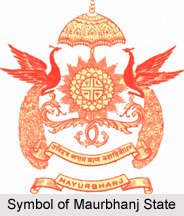 Princely State of Mayurbhanj was one of the princely states of India during the period of the British East India Company and later British Government in India.
Princely State of Mayurbhanj was one of the princely states of India during the period of the British East India Company and later British Government in India.
Formation of Princely State of Mayurbhanj
Princely State of Mayurbhanj was one of the largest states of the Eastern States Agency and one of the three states of the Bengal States Agency. The emblem of the state was two peacocks for according to legend the ancestors of the ancient rulers originated from a peafowl`s eyes.
Geography of Princely State of Mayurbhanj
Princely State of Mayurbhanj included a vast mountainous area inhabited by many different people groups such as the Shantal and Kisan people. The former territory of Princely State of Mayurbhanj lies in the present-day state of Odisha, bordering West Bengal. The capital of Princely State of Mayurbhanj was the town of Baripada since the 15th century and Daspur was another important town. Large tracts of Princely State of Mayurbhanj were covered with forest.
History of Princely State of Mayurbhanj
According to the history of Princely State of Mayurbhanj, Khijjinga Mandala, the predecessor state had ruled in unbroken succession since about the 9th century AD. The state had been named after its capital, Khijjinga Kotta, today Khiching. Copper plate inscriptions issued by the ancient rulers indicate that Khijjinga Mandala was an extensive territory comprising the present Mayurbhanj and Kendujhar districts as well as parts of Singhbhum district in Bihar and Midnapore district in West Bengal. During the Mughal period, the territory of the Bhanja rulers extended as far as the Bay of Bengal. By that time, the capital had shifted from Khijjinga Kotta to Haripur.
Architectural Splendour in Princely State of Mayurbhanj
The ruins of the temples and palaces of Princely State of Mayurbhanj built then can be found at Haripur about 16 km southeast of Baripada. Among the ruins, the Rasikaraya temple and the Durbar hall of the Bhanj kings are the most significant.
Rulers of Princely State of Mayurbhanj
The rulers of Princely State of Mayurbhanj were Rajputs of the Bhanj dynasty, tradition saying that since the mythical founder Sila Bhanja Angaddi they were the longest reigning clan of monarchs in the area. Since they had very good relations with the Mayur kings of Kendujhar, the Mayurs and the Bhanjas joined and gave origin to the name of the state.
Art and Culture in Princely State of Mayurbhanj
The Bhanj rulers were promoters of art, architecture and culture. The Hari Baladev Jiu Temple, the Khichhing temple and other architecture in and around the district stand testimony to this. Also the royal family was responsible for the development and promotion of the Chhau dance form which integrates martial, tribal and classical elements.
Related Articles
Modern History of India
British Empire in India
Princely States of India
Mayurbhanj District
Odisha



















